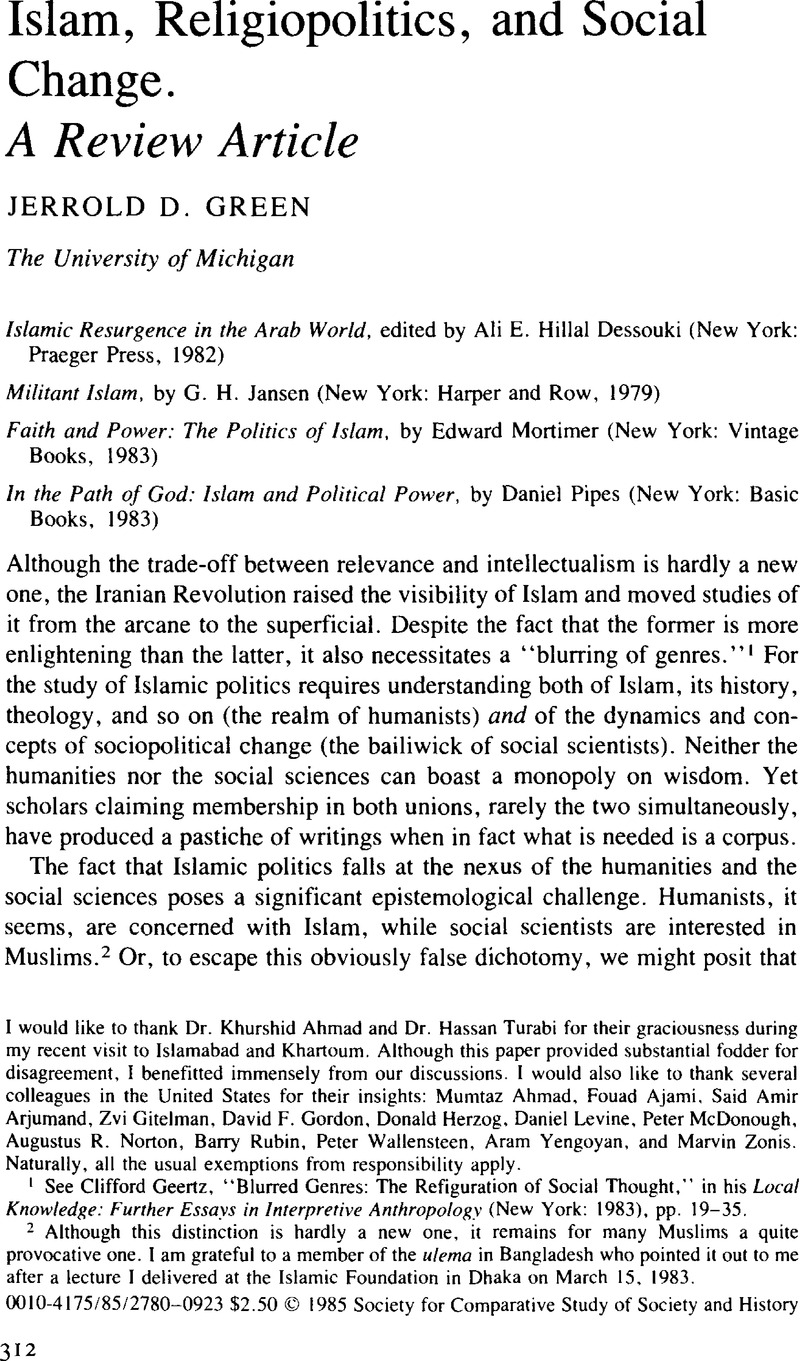Article contents
Islam, Religiopolitics, and Social Change. A Review Article
Published online by Cambridge University Press: 03 June 2009
Abstract

- Type
- Profane Uses of the Sacred
- Information
- Copyright
- Copyright © Society for the Comparative Study of Society and History 1985
References
1 See Geertz, Clifford, “Blurred Genres: The Refiguration of Social Thought,” in his Local Knowledge: Further Essays in Interpretive Anthropology (New York: 1983), pp. 19–35.Google Scholar
2 Although this distinction is hardly a new one, it remains for many Muslims a quite provocative one. I am grateful to a member of the ulema in Bangladesh who pointed it out to me after a lecture I delivered at the Islamic Foundation in Dhaka on March 15, 1983.
3 Gustave E. von Grunebaum points out this gap as well, writing: “The gap between what ought to be and what is, is strong in any religion, but it seems to be particularly strong in Islam.” Quoted in Pipes, p. 48. But von Grunebaum's concern here is with religion in a much more narrowly defined sense than is mine.
4 The preceeding quotations are from Huntington, Samuel P., American Politics: The Promise of Disharmony (Cambridge: 1981), p. 3.Google Scholar
5 Fischer, Michael M. J., Iran: From Religious Dispute to Revolution (Cambridge: 1981), p. 38.Google Scholar
6 This interesting fact was related to me by my late colleague Professor Richard Mitchell, a pioneer in the study of religiopolitical movements in Egypt. Personal communication, Spring 1982.
7 Weber, Max, The Sociology of Religion (Boston: 1963), p.235.Google Scholar
8 On the whole, the Mortimer volume is the more persuasive of the two.
9 For an analysis of the relationship between the two, see Levine, Daniel, “The Institutional Church and the Popular in Colombia,” mimeo., 1983.Google Scholar Fouad Ajami looks at this issue from a different perspective. Relying on transcripts of court proceedings from the trials of Islamic activists, Ajami cites debates between supporters of popular Islamic groups (the defendants) and de facto representatives of institutional Islam (the prosecutors). The issue has never been presented in quite this way and makes fascinating reading. See his “In the Pharaoh's Shadow: Religion and Authority in Egypt,” in Islam in the Political Process Piscatori, James P., ed. (New York: 1983), pp. 12–35.Google Scholar
10 Weber, Max, “Politics as a Vocation,” in Weber: Selections in Translation Runciman, W. G., ed. (New York: 1978), p. 223.CrossRefGoogle Scholar
11 Ibid., p. 222.
12 Ibid., p. 222.
13 Ibid., p. 220.
14 Green, Jerrold D., Revolution in Iran: The Politics of Countermobilization (New York: 1982), p. 150.Google Scholar
15 Humphreys, R. Stephen looks at the historical dimension of this issue in “The Contemporary Resurgence in the Context of Modern Islam,” in Dessouki, pp. 67–83.Google Scholar
16 For an excellent analysis of the relationship between political thought and practice from the perspective of the thinkers themselves, see Butterworth, Charles E., “Prudence Versus Legitimacy: The Persistent Theme in Islamic Political Thought.” in Dessouki, pp. 84–114.Google Scholar
17 For a discussion of this issue see “Pakistan: Islam as Nationality,” in Mortimer, pp. 186–229.Google Scholar
18 Saad Eddin Ibrahim has paid particular attention to this issue. See, for example, “Islamic Militancy as a Social Movement: The Case of Two Groups in Egypt,” in Dessouki, pp. 117–37. Members of the groups looked at by Ibrahim are primarily middle class in origin.Google Scholar
19 The exception is the Dessouki volume, which claims several excellent chapters.
20 Rahman, Fatlur, Islam and Modernity: Transformation of an Intellectual Tradition (Chicago: 1982), p. 150.Google Scholar
21 1n concert with the tools of social science they can be quite valuable, however. For the use of philology, for example, see Geertz, Clifford, “Deep Play: Notes on the Balinese Cockfight,” in his, The Interpretation of Cultures (New York: 1973), pp. 412–53.Google Scholar
- 1
- Cited by




